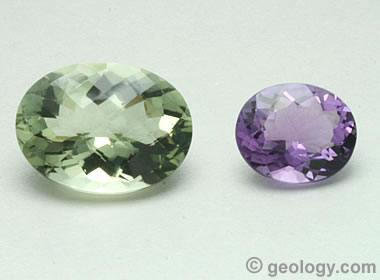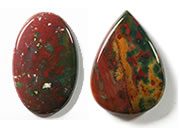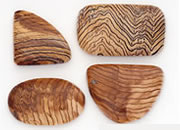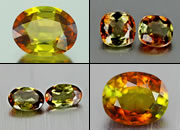Home » Gemstones » "Green Amethyst" and "Yellow Emerald"
"Green Amethyst" and "Yellow Emerald" are in the FTC's Crosshairs
Any use of an incorrect varietal name could be considered as "deceptive or misleading".
Author: Hobart M. King, PhD, GIA Graduate Gemologist

Prasiolite and Amethyst: Two faceted stones, prasiolite on the left and amethyst on the right. Prasiolite is a yellowish green to green material that is produced when natural amethyst is heated or irradiated.
Sellers and Buyers Beware
If you are a buyer or a seller of gems marketed under the names "yellow emerald" or "green amethyst" the Federal Trade Commission (FTC) wants you to know this: "It is unfair or deceptive to mark or describe an industry product with the incorrect varietal name."
Table of Contents
Proper Use of the Word "Amethyst"
The name "amethyst" is, by definition, a variety of the mineral quartz with a purple color. Using the word "amethyst" as a name for other colors of quartz or for other purple materials is incorrect. It is a misrepresentation of the variety name. "Green amethyst" is an incorrect name.
The proper name for the green quartz that people are calling "green amethyst" is prasiolite. Prasiolite is a green variety of quartz that occurs naturally. It is also a green variety of quartz that is produced by heat treatment or irradiation of amethyst and other quartz materials.

Heliodor: A round faceted heliodor with a golden-yellow color from Madagascar. It is not an "emerald" of any kind.
Proper Use of the Word "Emerald"
The name "emerald" is, by definition, a variety of the mineral beryl with a rich green color. Using the word "emerald" as a name for other colors of beryl or for other green materials is incorrect. These uses are also misrepresentations of the variety name. Such names are especially problematic when the name "emerald" is applied to varieties of beryl with a lower value than emerald. "Yellow emerald" is an incorrect name.
Specimens of beryl with a yellow color can properly be called heliodor, yellow beryl, or golden beryl. These names have a long history, and their use avoids confusion with a different material. Vendors should make a conscious effort to avoid any incorrect variety names as they could result in claims of deception or misrepresentation.
Federal Trade Commission Guidance
Section § 23.26 of the Federal Trade Commission's Summary of Basis and Purpose for the Revised Jewelry Guides addresses misrepresentation as to varietal name. They indicate:
(a) It is unfair or deceptive to mark or describe an industry product with the incorrect varietal name.
(b) The following are examples of markings or descriptions that may be misleading:
(1) Use of the term "yellow emerald" to describe golden beryl or heliodor.
(2) Use of the term "green amethyst" to describe prasiolite. [1, page 149]
The FTC is very clear that they do not like the terms "yellow emerald" used to market heliodor and "green amethyst" used to market prasiolite. Both incorrectly apply the varietal name. These names can be considered enticements that can deceive some consumers into paying inflated prices for heliodor and prasiolite.
Consumer Perception Evidence
In 2012, the Jewelers Vigilance Committe commissioned Harris Interactive to conduct a study that included the collection of consumer perception evidence on varietal names. Their study revealed three interesting items.
 41% of respondents stated that "yellow emeralds" are higher in value than "heliodors" 41% of respondents stated that "yellow emeralds" are higher in value than "heliodors" 41% of respondents stated that "yellow emeralds" are more valuable than "golden beryls" 41% of respondents stated that "yellow emeralds" are more valuable than "golden beryls" 44% of respondents stated that "green amethyst" is more valuable than "prasiolite" [1, page 73] 44% of respondents stated that "green amethyst" is more valuable than "prasiolite" [1, page 73]
|
| Information Sources |
|
[1] Summary of Basis and Purpose for the Revised Jewelry Guides; Federal Trade Commission; 16 CFR Part 23, 2018.
|
Marketplace Use of "Yellow Emerald" and "Green Amethyst"
In the recent marketplace, "yellow emerald" has been used by a small number of sellers compared to the use of "green amethyst". Jewelry and loose stones with the name "green amethyst" can be seen at many online stores. Anyone can use a search engine to find vendors who are still marketing these materials with incorrect varietal names after the Federal Trade Commission released their guidance to the jewelry trade. Various misspellings of the word "emerald" have also been used to market yellow beryl, and these names might cause confusion for some people.
| More Gemstones |
 |
Bloodstone |
 |
Rock Tumblers |
 |
Diamond |
 |
Opalized Wood |
 |
Tourmaline |
 |
Andalusite |
 |
Blue Gemstones |
 |
100+ Gems |

Find Other Topics on Geology.com:

|

| ||

|

| ||

|

| ||

|

|
